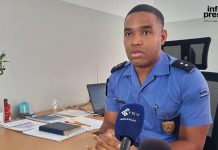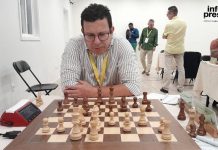By Sara Almeida
Africa-Press – Cape verde. In Santiago, there are more and more fishermen who use their boats for tourist trips, a supplement that helps to balance the accounts of life and the scarcity of fish. Mingo and Nelito, in Tarrafal, are two men of the sea who work in this activity and talk to us about their experience and, of course, fishing. The conversation inevitably involves the challenges faced and the climate changes that are becoming increasingly evident and are disrupting temperatures, fish and sea currents.
Born in Fazenda, “behind Monte Graciosa”, into a family of farmers who also worked as herders, Carlos Varela, better known as Mingo, has been fascinated by the sea since he was a child.
He moved to the town of Tarrafal when he was still young and whenever he could he would go to the beach, where he would watch the boats that returned from the sea full of fish. “Lots, lots of fish”, he recalls. He made friends with several fishermen and began asking them to take him to the fishing.
He was 13 years old when one of his “friends”, a man called Zé, let him go with him. Mingo, now 49, who knew nothing about fishing, managed to catch a tuna. “I was happy. The next day, I went again and caught a tuna and a sawfish”, he recalls with a smile. And from then on, he would even skip school to catch the fish that the sea gave him. He stopped studying. In any case, he recalls, there were no conditions for more school.
Carlos Alberto Varela – Mingo
At a certain point, the family, more used to working on the land, put him to work as a shepherd. “I would take the limes to Achada early”, leaving them there with his friends, and “run away to fish”, from which he would receive part of the money that the shipowner made from the sale. And that was how he lived his life. “The sea gave me income”, he says. “I have nothing bad to say about the sea, nothing to complain about. I am from the sea. All the things I need I have been able to get from the sea”, he says, rocked by the waves in his boat.
“A lot less fish”
The sea continues to be his livelihood. However, nowadays there are a lot less fish, he observes, a finding that the fishermen of Tarrafal say is corroborated by everyone in the more than 70 fishing communities in Cape Verde.
Mingo gives some reasons that he believes are the origin of this decrease. The first is that “there are a lot more boats” fishing. Furthermore, he estimates that from the 1990s onwards, the use of motors began to become more widespread, which allows fishing in more adverse weather conditions, such as wind and “rough water” – because “the sea has many moments”, and now to travel slightly longer distances.
In fact, it is very easy to cross the line between fishing and overfishing in Cape Verde. As biologist and environmentalist Tommy Melo explains, the coastal areas are very small, and the country does not have a “continental platform like West African countries, such as Mauritania or Senegal”. Therefore, since the demersal fishing area is very small and difficult to recover, “much more applied and serious management” is required in order to prevent overfishing.
Species that were previously relatively common are starting to become scarce, especially predators. And even the size of the fish caught is decreasing. “If we look at the average size of a grouper that was caught 20 years ago, it does not correspond to what is caught today. Therefore, we can see that the impacts are really being felt in this coastal strip”, points out the president of Biosfera.
Meanwhile, since the time Mingo began fishing, the number of semi-industrial fishing vessels has also increased. Currently, there are four vessels in Tarrafal. It was also from the 1990s onwards, according to the fisherman’s calculations, that the fish population began to decline. And there is another factor that Mingo highlights for this decline.
“There began to be a lot more construction”. Places along the coast that had no houses began to be dotted with buildings. With the construction came the search for sand. Places that used to have sandy beaches are now a pile of rocks. “Those who have studied more than me can tell you”, says Mingo, but he guarantees that this sand is important for the life cycle of the fish and, therefore, the collection of sand is a factor that contributed to the decline in fish.
According to biologist Tommy Melo, this does in fact happen. “A sandy beach takes thousands of years to form. Therefore, the ecosystem that lives there also took thousands of years to adapt to sandy bottoms. There are many species that need sandy bottoms for their life cycle, whether for reproduction, because they live near the sandy substrate, or for other reasons. Obviously, removing all the sand from a beach that took thousands of years to form in 10 years will cause an imbalance in the ecosystem, especially in these species”, he explains.
Tommy Mello – Biologist
Human action is, therefore, undoubtedly the destabilizing element, because although the sea sometimes takes the sand, “it brings it back
r”.
“Everything that goes into the sea, the sea takes back to land”, guarantees Mingo. Tommy Melo, in other words, corroborates the fisherman’s simple words.
“The hydrodynamics in coastal areas is already stable. The tidal cycles themselves, the annual seasonal cycles mean that sometimes the sand is removed from one side, placed on another, but it comes back. We are talking about cycles lasting thousands of years. Therefore, human interference in ending this sand deposit in such a short space of time really has an impact, considering that biodiversity cannot adapt to such a fast pace as the changes that are being imposed by man”, he explains.
Meanwhile, on his daily trips along the coast, Mingo no longer sees anyone collecting sand. Apparently, at least on his “route”, the practice has ceased.
Warmer water
Another factor that has changed the face of fishing in Cape Verde (and in the world) is the warmer climate, which also causes the water to warm up. “The climate has changed a lot,” notes Mingo. January used to be a cold month, when everyone complained about the low temperatures, especially at night. Not anymore. “These days, January is not cold,” he says.
But it is in the months between May and September that the biggest difference in fishing and possible impacts can be seen. Those were months when there was a lot of fish, “bottom fish, surface fish, there was everything, and in quantity. Today, there are few fish. Pexi sta poku.”
The effects of the increase in temperature on fishing are well-known. Some species have difficulty reproducing in warmer waters; the increase in temperature can cause the death of corals, and therefore the disappearance of the habitat of some species; warm water retains less oxygen, which affects the entire aquatic environment and facilitates the excessive growth of algae, which, when decomposed, consume even more oxygen.
And another phenomenon is also occurring: the change in species in fishing areas.
The change in temperature causes “some schools of fish to move mainly northwards in search of colder waters”, explains biologist Tommy Melo.
There is a very clear example in Cape Verde. A few years ago, a species of mackerel that was uncommon in these waters and lived further south began to appear in its waters. Now, this mackerel is being caught in large numbers, sometimes even more than was previously found in the archipelago. Eventually, the “traditional” mackerel is also migrating northwards. There is still no scientific data to corroborate this finding, but on the ground it seems that this is what is happening.
Closed season
However, in addition to the increase in fishing, all fishermen recognise that the closed seasons, as well as the ban on fishing for juveniles, are good practices that must be followed.
“If the fish do not spawn, we will not have any fish later on, and if we catch them small, we will not have any big fish”, they summarise.
But they also all look at the other side: the side of the fisherman who is left without his income. And so, they all recognize that these rules are not followed.
“Your bread is there. So, it’s like a fight between the authorities and the fishermen, because their bread is being affected”, observes Mingo. “We need to make another move, to compensate the fishermen financially, so that they don’t catch these fish”, he advises.
Also on the side of environmentalists, the solutions to improve fishing involve being able to implement certain rules in fishing. “These are merely management solutions, and there is no need to reinvent the wheel here. They already exist, they have been applied for a long time in other countries”.
Cape Verde has these solutions written in laws and regulations but not in practice: “there needs to be rest areas, there needs to be effective marine reserves and for monitoring to actually take place”, summarizes Tommy Melo. However, the difficulty in implementing this is recognized, because it affects the “bread”. Therefore, he recommends, “the government must find alternative sources of income for these families who will be left without this subsistence because the fishing areas they used to use really need to rest in order to recover the fauna that existed there”.
Boat trips
The fish stocks have been decreasing and although he can still make a living from fishing, like many other fishermen, Mingo found a way to increase his monthly income a little since 2012. A French friend, who owns a hotel in Tarrafal, with whom he used to go to the sea for leisure, gave him the idea of renting out the boat for tourist trips. See the coast, go snorkeling or fish. At the hotel, his friend advertised this service and Mingo then became a kind of guide.
In Tarrafal, there are currently 11 boats registered for this ecotourism activity, as he recalls from a meeting they had with the Maritime Port Institute (IMP).
This meeting, he also says, also served as a kind of training on working conditions and the equipment they should have, namely first aid, in addition to the essential vests. In fact, there is no guide thatdoes not care about the safety with which it transports its tourists, whether national or foreign.
And so it goes. Mingo and several others alternate between the two activities. “There are times when fishing brings in more than tourism, and other times when tourism brings in more. But when fishing brings in more, the income is greater. Sometimes, in a day I make 40 or 50 contos and I know people who even make 100 contos in a day”. But this is not always the case. So, one helps to balance the other.
Nelito Semedo Tavares, better known as Né, is another tour operator from Tarrafal who runs boat trips, with fishing, snorkeling and other nautical activities included, according to the client’s wishes. He is also the one who represented Cape Verde twice “in the 5 km crossing in Dakar”, as a lifeguard and fisherman.
He is said to have been one of the first sons of Tarrafal to get a boat for recreational activities with tourists. He did it in 2010, when there was less competition and the activity was more profitable, but he continues to alternate this activity with the others he dedicates himself to, all of which are focused on the sea.
While he is also talking about the trips from his boat, he highlights that for tourists who like fishing, it is always a great joy when they manage to catch a fish. But whether for leisure or as a primary source of income, there are fewer and fewer fish.
Like a tide, we return to fishing.
image
Nelito – Nelito Tavares
“Before, we would catch 10 tuna, now it is one, sometimes two”, he says. In fact, his experience is very similar to Mingo’s. Few fish, changes in the climate, overfishing. But also complaints. “We fishermen are a bit abandoned because we don’t have much support. We have support for the engine and the boat, but we need support in terms of new fishing technologies”. As an example, he mentions the need for “equipment such as probes with GPS”. In fact, Nelito already has this equipment and can use it to catch more fish, but many other fishermen still don’t.
He also feels that there is a lack of support and training in terms of raising awareness about climate change and its impacts, particularly on currents. “We have recently noticed that in our fishing area, every now and then there is a current of cold water and a current of warm water, it is not normal. One day hot, one day cold. One day with fish, one day without fish”, he points out.
At the same time, he believes that there is a need for more training on fish species: which are endemic, which are protected, what size they should be. “Fishermen should know all this, if we don’t know, we will destroy the marine ecosystem itself, we will destroy everything”, he observes.
A position that Tommy Melo also supports. The environmentalist recognizes the enormous potential of Cape Verde in tourism, but, as he warns, “we are depleting the environment much faster than we can use it for tourism”.
As an example, he mentions the aforementioned sand extraction that destroys the beaches, the shocking constructions on the coastline, and the overfishing that continues without “regulation being really imposed”.
“In other words, we are here in a parallel where, if we do not start taking measures, even the potential that Cape Verde may have for tourism development and for attracting tourists, may be lost before we even start to use it”, he sums up.
Taking the leap
All of this is happening in a country where the Blue Economy, more than a flag, is a basic necessity for its future.
As highlighted in the Climate Change and Development Report (CCDR), prepared by the World Bank and recently presented, it stresses that “creating a climate-adapted blue economy is at the heart of Cape Verde’s development plans”.
To this end, its beaches and marine fauna are fundamental for “tourism and fishing, pillars of the economy”, the document stresses.
The report, which estimates the impact of climate action on the country’s GDP, recalls that tourism, which generates 25% of GDP and 45% of jobs in the formal sector, faces challenges such as rising temperatures “and the environmental impact of poorly planned coastal development”. Fisheries, whose product constitutes the second largest source of protein in the country’s diet and accounted for 72% of exports in 2021, suffers from overfishing and poor management, damaging both fishermen’s incomes and access to seafood. In the case of fisheries, it is essential to create protection zones, regulate capture techniques and explore new forms of production, such as aquaculture and seaweed cultivation.
In fact, based on the conclusions of the CCDR, a set of recommendations was drawn up around seven strategic objectives, among which is “Developing a climate-resilient blue economy” (tourism, fisheries, oceans). To this end, support for research and monitoring of fisheries resources is recommended. It is also recommended to promote sustainable fishing with regulations, no-fishing regeneration zones and standards/certifications for processed products,while aquaculture is increasing. At the same time, it is pointed out that it is necessary to diversify tourism beyond sun and beach, including hiking, yachting, cultural exploration and creative initiatives, reducing the environmental and carbon impact of the sector. And finally, to protect coastal ecosystems and encourage climate adaptation in the private sector.
The data in the report therefore coincide with the empirical perception of those who make their living from the sea, the true players in the blue economy.
However, reality has clashed with the intentions of the reports. We saw this in the testimonies above, and also in a particular experience that Nelito tells us about. In 2019, the guide swimmer participated in a competition on blue entrepreneurship, promoted by Pro-Empresa. “I made it to the final, in São Vicente”, he says happily.
Today, he has a business plan ready to implement, but one obstacle has been insurmountable: a lack of funding. The bank informed him that it needs 20% of the 7 thousand contos expected in order to be able to release the loan. Other sources of financing also require guarantees that he cannot provide at the moment. To date, he has not been able to move forward.
“I would like to have a sport fishing boat so that I can participate in the Blue Marlin fishing championships here in Cape Verde, and also fish with tourists. For example, going with them to the coast of Maio. That is my dream. I hope that one day I can get there”, he says, with the resilience typical of someone who makes a living at sea.
Source: expressodasilhas.
For More News And Analysis About Cape verde Follow Africa-Press






